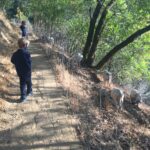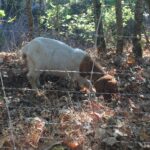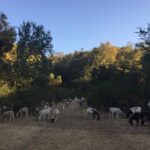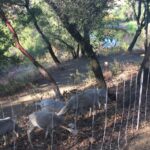September 23, 2021
Posted in: News Articles
Have you gone for a hike at Healdsburg Ridge Open Space Preserve recently? If so, you may havseen the sheep and goats working their way around the preserve to help create buffers between the preserve and the city of Healdsburg in preparation for the current and future wildfire seasons.
The City of Healdsburg was awarded grant funds by the Coastal Conservancy to bring in grazing sheep and goats to help remove ladder fuels on Healdsburg Ridge, Fitch Mountain Open Space Preserve, and the privately-owned Callahan property. These neighboring properties all have Ag + Open Space conservation easements to protect their incredible wealth of natural resources like critical wildlife habitat and corridors, Russian River tributaries, and a hugely diverse swatch of plant species. We’ve been supporting the City’s work by reviewing their grazing plans to ensure this much needed fire-fuel reduction protects the unique natural features of these lands.
In recent years, all three properties have been threatened or directly impacted by wildfire. Sitting just to the east of Healdsburg, these properties lie in what’s known as the wildland-urban-interface, or “WUI”, which is where our cities and towns meet natural, open spaces. These zones have become even more critical in recent years as large wildfires become more common. The open spaces, when effectively managed, are able to create space that can help buffer urban areas during wildfires, while also providing space for firefighters to stage and create containment lines.
To create these buffers, grazing goats and sheep are helpful in clearing out ladder fuels, or the small plants and trees that can help fires move from the ground to the tree canopy. Ladder fuels can also help fires move more swiftly across large landscapes. Grazing can help create and maintain areas called “calming zones”, or large areas of open space where ladder fuels are thinned to provide less opportunity for fire to spread. Over the last several years, the City of Healdsburg has created shaded fuel breaks on these properties as well. Shaded fuel breaks are similar to calming zones in that ladder fuels are removed, but shaded fuel breaks are a more aggressive treatment that removes more ladder fuels closer to stands of trees, and in smaller and more specific areas. Calming zones and shaded fuel breaks are meant to give the fire less opportunity to spread and intensify. Last year, the City also held a prescribed burn at Healdsburg Ridge, and will continue their vegetation management work across the three properties in the years ahead.
Vegetation management requires a balance between the removal of fuels that have built up, and the protection of our natural resources to preserve the biodiversity of our ecosystems. During this grazing project, we have worked closely with the City of Healdsburg to carefully plan where the animals can roam and what they can eat. For instance, in an area of Healdsburg Ridge, they’ve carefully planned around Baker’s manzanita, a very rare federally-listed shrub species that is native to Sonoma County.
Keeping invasive plants and ladder fuels at bay on these three properties, as well as others in the WUI, will be critical in maintaining the long-term health of our natural and working lands, and the safety of our cities and towns. We’re glad to support the vital work being done by the City of Healdsburg to ensure these lands continue to flourish and protect us. Learn more about our work preparing for and recovering from wildfires >>
More about these protect lands
In 2003, Ag + Open Space acquired two properties along a prominent ridgeline on the northeastern side of Healdsburg to create the 153-acre Healdsburg Ridge Open Space Preserve. The preserve encompasses the headwaters of two drainages to the Russian River, boasts many scenic vistas, and is home to pacific madrones and six species of oaks, California maidenhair fern and California oat grass, and great egret and white-tailed kite, in addition to many other plant and animal species. The preserve is also home to a lacustrine habitat called Fox Pond. Lacustrine habitats are found statewide, and are visited for reproduction, cover, food and water by 101 bird species, 18 mammal species, 22 amphibian species, and 9 reptile species. Ag + Open Space also helped develop 3.5 miles of trails across the preserve. We transferred the preserve to the City of Healdsburg in 2019, and as part of the transfer, Ag + Open Space retains a conservation easement that will protect the preserve’s diversity of habitats, and a recreation covenant to ensure the preserve remains open to the public, forever.
Fitch Mountain Park & Open Space Preserve is 180-acres of dense forests and prominent peaks that overlook the Russian River and the City of Healdsburg. Ag + Open Space acquired a conservation easement over the property in 1997, and in 2014 purchased the property and transferred it to the City of Healdsburg to create a new public park and preserve. The City has worked with LandPaths on restoration work throughout the park, which is home to redwoods and oaks, rare plants like canyon larkspur and Napa false indigo, and 40 bird species including Cooper’s hawks and great blue herons.
Callahan is a 106-acre private property we protected with a conservation easement in 1996, protecting its vast natural resources including live and valley oaks, ample space for wildlife, and its location along the Russian River.



